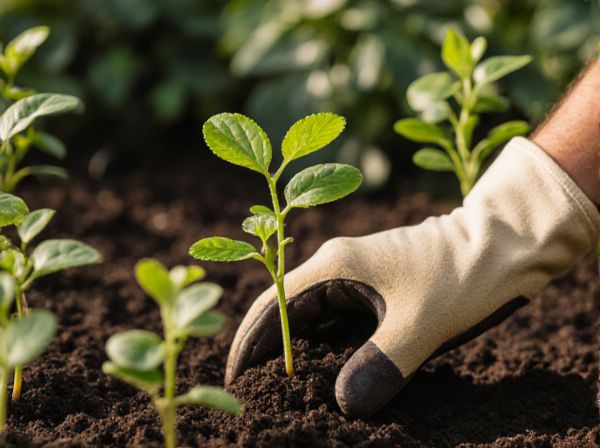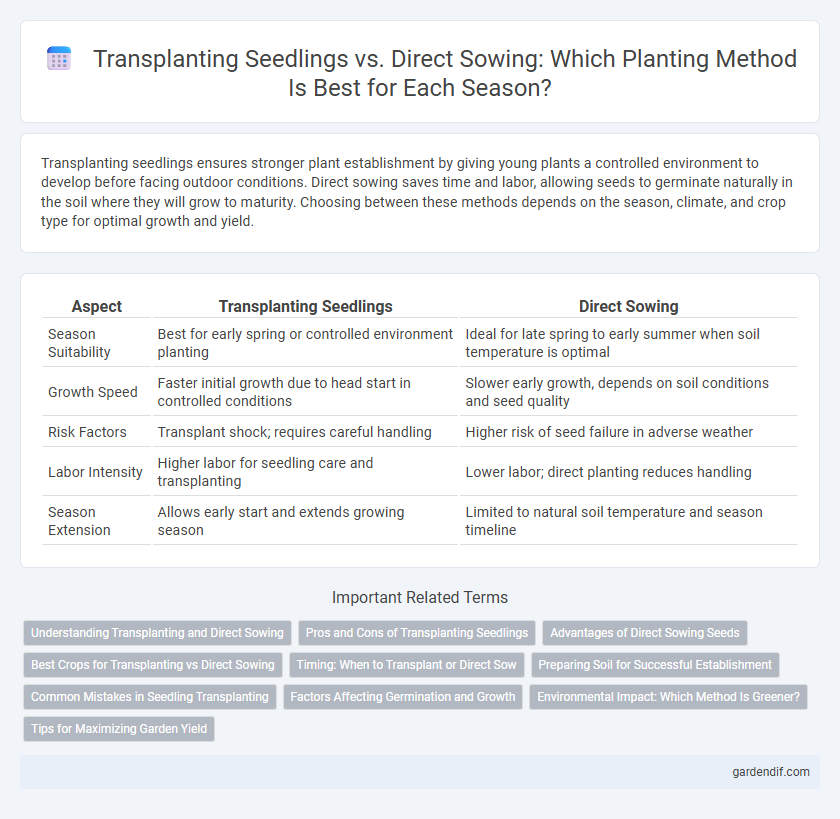
Transplanting seedlings vs Direct sowing Illustration
Transplanting seedlings ensures stronger plant establishment by giving young plants a controlled environment to develop before facing outdoor conditions. Direct sowing saves time and labor, allowing seeds to germinate naturally in the soil where they will grow to maturity. Choosing between these methods depends on the season, climate, and crop type for optimal growth and yield.
Table of Comparison
| Aspect | Transplanting Seedlings | Direct Sowing |
|---|---|---|
| Season Suitability | Best for early spring or controlled environment planting | Ideal for late spring to early summer when soil temperature is optimal |
| Growth Speed | Faster initial growth due to head start in controlled conditions | Slower early growth, depends on soil conditions and seed quality |
| Risk Factors | Transplant shock; requires careful handling | Higher risk of seed failure in adverse weather |
| Labor Intensity | Higher labor for seedling care and transplanting | Lower labor; direct planting reduces handling |
| Season Extension | Allows early start and extends growing season | Limited to natural soil temperature and season timeline |
Understanding Transplanting and Direct Sowing
Transplanting seedlings involves starting plants indoors or in a protected environment before moving them to the garden, offering better control over germination and early growth stages. Direct sowing means planting seeds directly into the soil, which can reduce transplant shock and is suitable for plants with delicate root systems. Choosing between these methods depends on the season, climate conditions, and the specific crop's growth requirements.
Pros and Cons of Transplanting Seedlings
Transplanting seedlings enables gardeners to extend the growing season by starting plants indoors under controlled conditions, leading to stronger initial growth and improved survival rates. This method allows for better spacing and weed control but can cause transplant shock, which may temporarily stunt growth or reduce yield. Compared to direct sowing, transplanting requires more time, effort, and resources, making it less suitable for all plant types or large-scale cultivation.
Advantages of Direct Sowing Seeds
Direct sowing seeds enables plants to establish deeper root systems by growing in their natural environment without disturbance, leading to stronger and more resilient crops. It reduces transplant shock, promoting faster germination and healthier seedling development. This method also saves time and labor costs while minimizing soil disruption, supporting sustainable farming practices during the active growing season.
Best Crops for Transplanting vs Direct Sowing
Tomatoes, peppers, and eggplants thrive best when transplanted as seedlings, allowing for a controlled environment during early growth and protection from adverse weather. Carrots, radishes, and beans are ideal for direct sowing, as they tend to have delicate roots and grow quickly, making seedlings fragile and difficult to transplant. Leafy greens like lettuce and spinach can adapt well to both methods but typically benefit from transplanting to extend the harvest season and improve yield.
Timing: When to Transplant or Direct Sow
Transplanting seedlings is ideal in early spring or late summer when soil temperatures range between 50-70degF, promoting optimal root establishment before extreme weather. Direct sowing is best done when the soil has warmed to at least 60degF, ensuring seed germination and reducing the risk of frost damage. Timing varies by plant species, with cool-season crops favoring early sowing and warm-season crops requiring later planting dates for successful growth.
Preparing Soil for Successful Establishment
Preparing soil for successful establishment requires loose, well-drained soil rich in organic matter to support healthy seedling roots or germinating seeds. Transplanting seedlings benefits from moist, nutrient-dense soil that encourages root adaptation, while direct sowing demands fine, crumbly soil to ensure good seed-to-soil contact and moisture retention. Both methods need soil pH balanced around 6.0 to 7.0 and appropriate temperature conditions for optimal seedling growth and development.
Common Mistakes in Seedling Transplanting
Common mistakes in seedling transplanting include disturbing the root system, which can lead to transplant shock and stunted growth. Overwatering or underwatering immediately after transplanting compromises seedling survival and can cause root rot or dehydration. Planting seedlings too deep or too shallow disrupts their development and reduces overall yield during the growing season.
Factors Affecting Germination and Growth
Temperature, soil moisture, and light intensity critically influence germination rates and seedling vigor. Transplanting seedlings allows control over these variables by starting growth in optimal conditions, reducing risk from early environmental stress. Direct sowing exposes seeds to natural fluctuations in weather and soil conditions, which can affect germination uniformity and lead to varied growth outcomes.
Environmental Impact: Which Method Is Greener?
Transplanting seedlings reduces the risk of seedling loss and soil disturbance, leading to better resource efficiency and less environmental degradation. Direct sowing minimizes the need for plastic trays and greenhouses, lowering energy consumption during the growing process. Evaluating carbon footprints, direct sowing often has a smaller environmental impact, but transplanting can optimize land use and water efficiency, supporting sustainable agriculture practices.
Tips for Maximizing Garden Yield
Transplanting seedlings allows for early germination and stronger plant establishment, giving crops a head start in the growing season. Direct sowing promotes root development without disturbance, ideal for plants sensitive to transplant shock. To maximize garden yield, choose transplanting for crops with longer growth periods and direct sowing for fast-maturing or root-sensitive plants, ensuring optimal spacing and timely watering.
Transplanting seedlings vs Direct sowing Infographic

 gardendif.com
gardendif.com